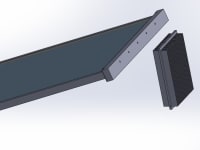In recent days increasing demand and cost of electrical energy acts as driver for growth
in global market for solar energy. Being a source for generation of electricity
photovoltaic technology finds its application in many fields. This works by the generation
of power using photovoltaic cells. But still ways to obtain maximum efficiency from these
cells are one the research line. These low efficient of never ending energy source has a
huge scope for the renewable energy picture of the future.
The main disadvantage is the solar cells are highly sensitive to increase in temperature.
As they are constantly exposed to sunlight for the generation of power heating is
inevitable. But cooling systems can be designed to maintain the temperature of the cell.
This may result in a significant save in energy. It can be done by passing a layer of fluid
over the solar cells as a medium of heat transfer. This fluid is dielectric since it should
not conduct any electricity which may otherwise short circuit the panel. The driving
power to the fluid can be obtained using a pump or by natural convection.
A thermosiphon loop is a very efficient way to drive the fluid as it uses buoyancy as the
driving force and can circulate the fluid effectively. The fluid gets heated up by
absorbing the heat from the panel. This hot fluid being less dense rises up and
circulates eventually losing the heat to the atmosphere. A thermosiphon loop design can
be used to cool the panel without any external driving force such as a pump effectively.
The illustration represents a three dimensional model of the system. Dielectric fluid is passed between the the panel (fluid goes over) and the glass (fluid goes under), which then gets cooled at the heat sink. The cooling system is a fin based type heat exchanger. It gets cooled by natural convection eliminating the need for a fan. This is a closed loop continuous cycle.
Heat Exchanger
Material: Aluminium
Fin Length: 0.05m
Number of Fins: 21
Thickness of Fin: 0.005m
Air Gap: 0.00975m
Fin Efficiency: 0.986
Manifolds and tubes can be used to circulate the fluid.
For a 250 Watts panel, the maximum instantaneous save in energy that can be obtained is 21 Watts.
Like this entry?
-
About the Entrant
- Name:Liwaans Ajith Antonit A
- Type of entry:individual
- Patent status:none





